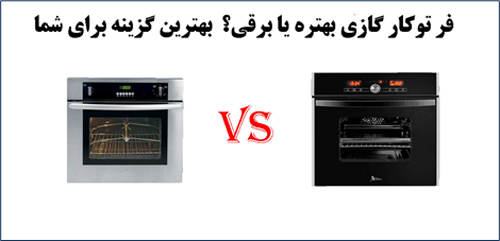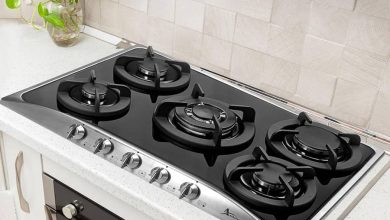In the modern world of cooking, it is becoming more and more important to use technology to prepare delicious and healthy food. Today, built-in ovens are a popular appliance in kitchens. But is it better to use a gas or electric built-in oven? In this article, we will examine the advantages and disadvantages of both types of built-in ovens and help you make the best choice based on your needs. After reading this article, if you intend to buy a built in oven at the best price and also have the option to pay at home, you can use the above link to purchase from the official website of Akhwan Jam products with a free consultation.
Advantages of a built-in gas oven
The ability to cook at a high temperature
A built-in gas oven has the ability to cook at high temperatures due to the use of fire to generate heat. This feature can be very useful in cooking some foods that require high temperatures.
Lower operating cost
Using a built-in gas oven is usually associated with a lower operating cost. Natural or domestic gas that you use as fuel.
Disadvantages of a built-in gas oven
need gas
The use of a built-in gas oven requires the installation of a gas network in the kitchen. This requirement may lead to increased cost and trouble for you. Also, in cases where there is no gas network in the desired location, it can be difficult to install.
Possibility of gas leakage
The use of a gas built-in oven is associated with a risk of gas leakage. If not properly installed and troubleshooted, there is a possibility of accidents such as fire and explosion. Therefore, you must ensure the correct and periodic installation and maintenance of the built-in gas oven and observe the necessary precautions in this field.
Advantages of the built-in electric oven
heating speed
The built-in electric oven heats up faster due to the use of heating elements. This means less time to prep and start cooking. If you need speed in your kitchen, a built-in electric oven is a good choice.
Ease of use
A built-in electric oven is much easier to use than a gas oven due to the simplicity of controlling the temperature and cooking time. You can easily adjust all the settings and start cooking your food.
Disadvantages of the built-in electric oven
High power consumption
One of the complications of using a built-in electric oven is its high electricity consumption. Due to the use of electric heating elements, its energy consumption is higher than that of a gas built-in oven. As a result, your monthly electricity bill may increase.
The ability to cook at limited temperatures
Built-in electric ovens usually have limits on cooking temperatures. When you need to cook at certain temperatures, a built-in electric oven may not be for you. In this case, you should make sure of the adjustable temperature capabilities of the oven.
Comparison of gas and electric built-in ovens
| Property | Built-in gas oven | Built-in electric oven |
| power source | Natural gas, propane, butane and … | electricity |
| stabilizing | The need to install a gas network or a gas tank | Need to install adjustable electricity |
| Energy efficiency | High efficiency and optimal use of heat | Energy efficiency may be lower |
| Warm up time | Heats faster than electric ovens | Need more time to warm up |
| Temperature and time control | The ability to accurately set the temperature and cooking time | Temperature and time controls can be set but may be less accurate |
| Operation and maintenance costs | The cost of gas and the maintenance and repair of the gas network | The cost of electricity and electronic repairs |
| safety | Possible risk of gas leakage and fire | Electrical and fire hazards |
| simultaneous cooking | Possibility of simultaneous cooking in most models | In some models, it may have a limit |
| impact on the environment | Emission of greenhouse gases and air pollutants | Without direct production of greenhouse gases and air pollution |
Factors influencing the selection of a built-in oven
There are many factors affecting the choice between gas and electric built-in ovens. Some of these factors are:
types of foods
The type of food you usually cook can influence the choice of built-in oven. For foods that require high temperatures, a built-in gas oven may be the best choice. At the same time, for foods with limited cooking temperatures, a built-in electric oven may be more suitable.
available space
Dimensions and space available in the kitchen also play an important role in choosing a built-in oven. If you have limited space in your kitchen, a built-in electric oven, which is often smaller than gas, may be the best choice.
budget
Finally, your budget also influences the choice of a built-in oven. Built-in electric ovens are usually cheaper to purchase and install, but they consume more electricity. On the other hand, a gas built-in oven costs more to install and maintain, but can save in terms of operating costs.
The last word
In this article, we have examined the advantages and disadvantages of gas and electric combined ovens. A built-in gas oven has the ability to cook at higher temperatures and a lower operating cost, but it requires gas to be installed and may carry gas leakage risks. On the other hand, the built-in electric oven has a high heating speed and ease of use, but it consumes more electricity and has the ability to cook at limited temperatures.
When choosing between a gas and electric built-in oven, the type of food you usually cook, the space available in your kitchen, and your budget also have an impact. Given these factors, you can make the right decision about choosing a built-in oven.
Also, keep in mind that it is important to use both types of built-in ovens correctly and safely. If you are using a built-in gas oven, make sure it is installed correctly and always be careful about gas leaks. On the other hand, when using a built-in electric oven, you should also pay attention to the manufacturer’s safety instructions and always keep the appliance in mind.
Finally, before purchasing any type of built-in oven, it is best to check the market and compare different products. Other people’s opinions and experiences can also be helpful in making your choice. Finding the right built-in oven with pros and cons that meets your needs and requirements should be your ultimate goal.











